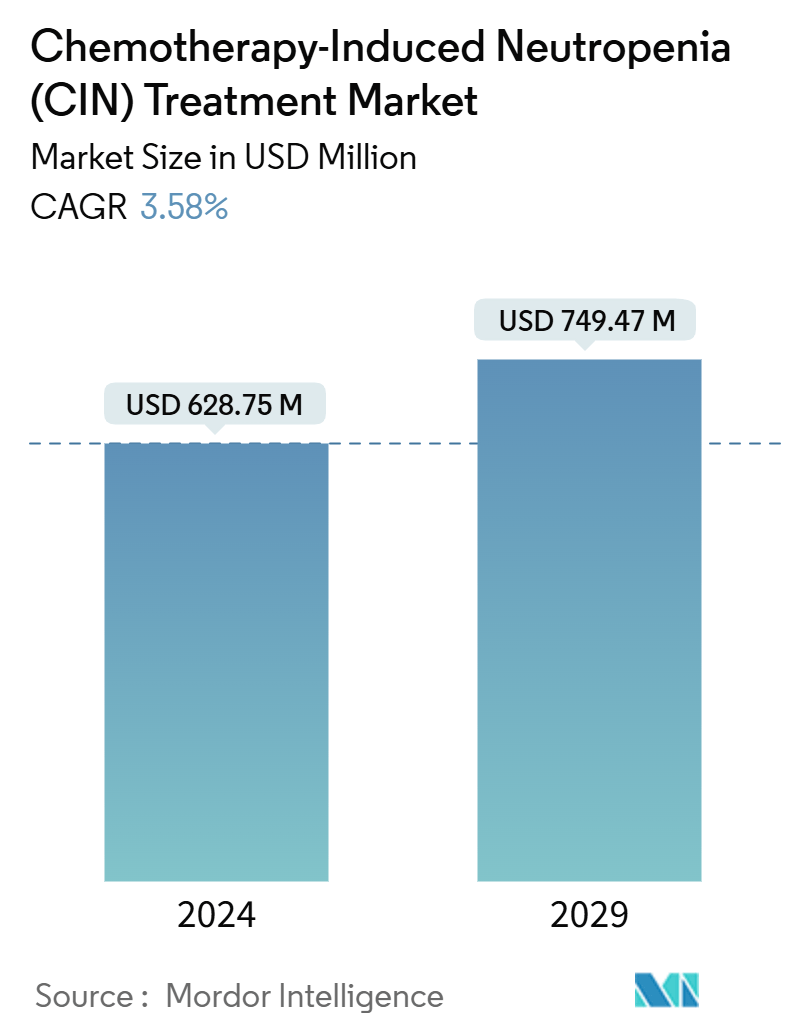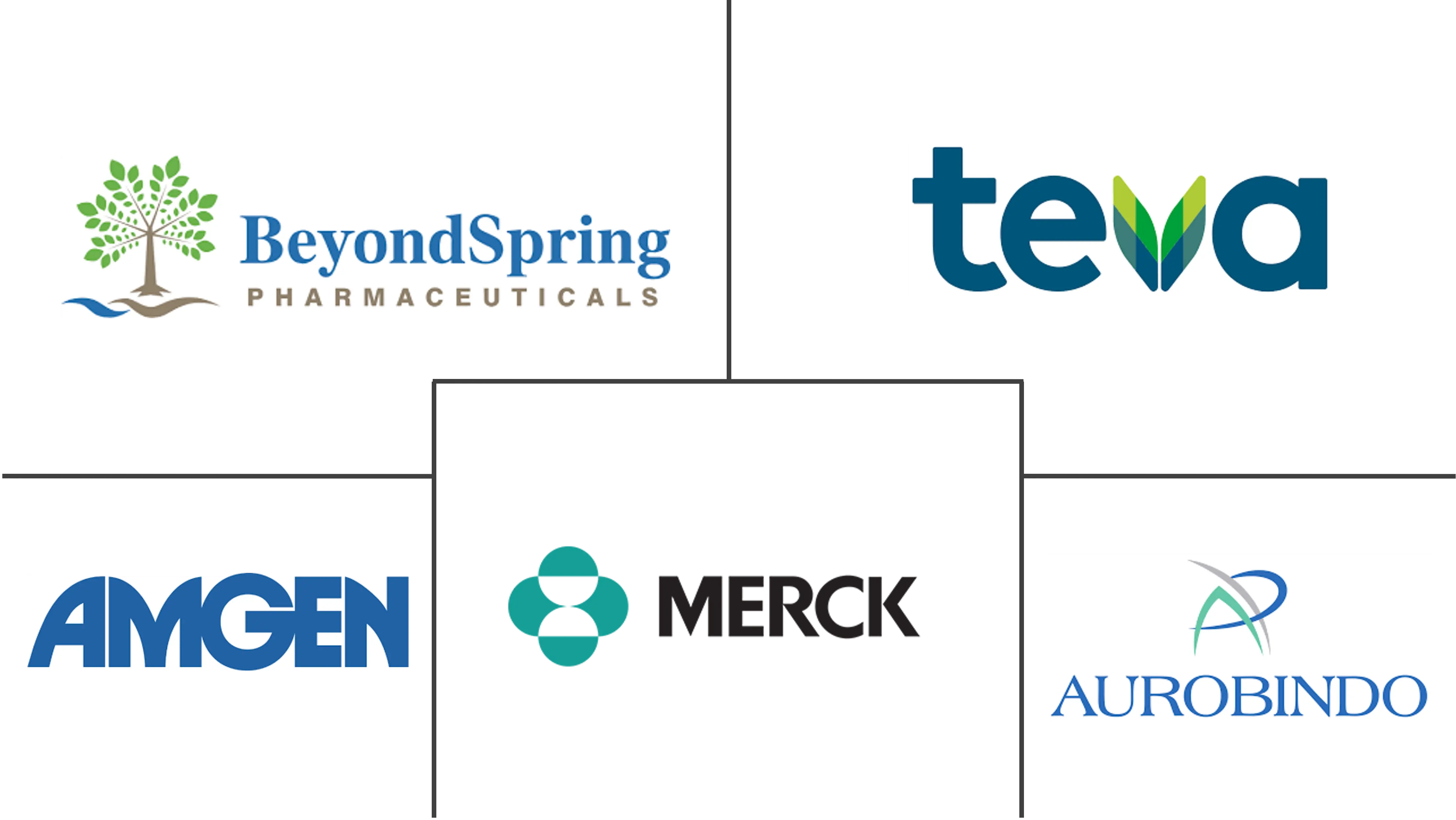Market Size of Chemotherapy-Induced Neutropenia (CIN) Treatment Industry

| Study Period | 2019 - 2029 |
| Market Size (2024) | USD 628.75 Million |
| Market Size (2029) | USD 749.47 Million |
| CAGR (2024 - 2029) | 3.58 % |
| Fastest Growing Market | Asia-Pacific |
| Largest Market | North America |
| Market Concentration | Medium |
Major Players
*Disclaimer: Major Players sorted in no particular order |
Chemotherapy-Induced Neutropenia (CIN) Treatment Market Analysis
The Chemotherapy-Induced Neutropenia Treatment Market size is estimated at USD 628.75 million in 2024, and is expected to reach USD 749.47 million by 2029, at a CAGR of 3.58% during the forecast period (2024-2029).
The outbreak of COVID-19 impacted the chemotherapy-induced neutropenia (CIN) treatment market. The massive volume of COVID-19 patients and the lockdown disrupted the diagnosis and treatment of non-COVID-19 diseases such as cancer. The decrease in the number of cancers led to a decline in chemotherapy and chemotherapy-induced neutropenia, hampered the demand for chemotherapy-induced neutropenia treatment. For instance, a study published in the European Journal of Epidemiology in January 2023 stated that there had been a decline of over 27.0% in the volume of cancer diagnoses amid the pandemic globally. However, in the post-pandemic period, the volume of COVID-19 patients decreased, which led to the resumption of the diagnosis and treatment of other chronic diseases, such as cancer, and it enabled the market to grow normally. For instance, in February 2021, Tata Memorial Hospital in India reported that the normal count of cancer patients was resumed at the cancer OPD of the hospital after the pandemic. Thus, the pandemic imposed an adverse impact on the chemotherapy-induced neutropenia (CIN) treatment market initially; however, with the decrease in the number of COVID-19 cases, the resumption of the diagnosis and treatment of cancer and the increasing volume of chemotherapy-induced neutropenia (CIN) treatment, the market is growing at a normal pace. It is expected to continue the same over the forecast period.
The increasing prevalence of cancer, rising use of chemotherapy treatment, and increasing research and development activities are the major drivers for the market.
The rising prevalence of cancer and the increasing use of chemotherapy for its treatment has led to an increased use of chemotherapy-induced neutropenia in cancer patients. For instance, as per the American Cancer Society Colorectal Cancer Statistics in 2023, over 153,020 adults are estimated to be diagnosed with colorectal cancer 2023 in the United States. These numbers include 106,970 new cases of colon cancer and 46,050 new cases of rectal cancer in the United States. Furthermore, the data published by the Australian Institute of Health and Welfare in August 2022 stated that over 151,000 new cancer cases were estimated to be diagnosed in Australia in 2021. Thus, such a rising burden of cancer is expected to elevate the number of chemotherapy-induced neutropenia in cancer patients. Therefore, these factors will boost the treatment demand, driving the market growth over the forecast period.
Furthermore, many research studies have highlighted the high risk of developing neutropenia in chemotherapy patients. For instance, an article published in the eCancer Medical Science in February 2021 stated that during chemotherapy, one out of every three patients of breast cancer included in the study developed neutropenia while on chemotherapy. Thus, with the high burden of cancer and the high volume of chemotherapy, the number of chemotherapy-induced neutropenia is expected to increase, which in turn is expected to accelerate the demand for neutropenia treatment products, propelling the market growth.
Moreover, the recent developments by the market players are expected to increase the penetration of treatment products intended to manage chemotherapy-induced neutropenia. For instance, in March 2022, the U.S. FDA approved the Biologics License Application (BLA) of Amneals' filgrastim-ayow, a biosimilar referencing Neupogen used to treat chemotherapy-induced neutropenia. Further, in February 2021, G1 Therapeutics, Inc. received approval from the U.S. FDA for its therapy drug, COSELA (trilaciclib). The drug is intended to manage chemotherapy-induced myelosuppression in adult patients when administered before a platinum/etoposide-containing regimen or topotecan-containing regimen for extensive-stage small cell lung cancer (ES-SCLC).
Therefore, owing to the abovementioned factors, such as the increasing burden of cancer, the high volume of chemotherapy, and the high risk of developing chemotherapy-induced neutropenia, the market is expected to show significant growth over the forecast period.
However, the high cost of neutropenia treatment and strict rules and regulations for product approvals are expected to restrain the growth of chemotherapy-induced neutropenia (CIN) treatment over the forecast period.
Chemotherapy-Induced Neutropenia (CIN) Treatment Industry Segmentation
As per the report's scope, neutropenia is a condition in which the number of white blood cells (neutrophils) in the blood is reduced, lowering the body's ability to fight infections. Chemotherapy-induced neutropenia (CIN) is a common side effect of administering anticancer drugs. This adverse effect has been linked to life-threatening infections and can potentially change the chemotherapy regimen, affecting both short- and long-term outcomes. The Global Chemotherapy-Induced Neutropenia (CIN) Treatment Market is Segmented by Treatment (Antibiotic Therapy, Granulocyte Colony-Stimulating Factor Therapy, Granulocyte Transfusion, and Other Treatments), Distribution channel (Hospital Pharmacies, Retail Pharmacies, and Online Pharmacies), and Geography (North America, Europe, Asia-Pacific, and Rest of the World). The report also covers the estimated market sizes and trends for 17 countries across major regions globally. The report offers the value (in USD) for the above segments.
| By Type | |
| Antibiotic Therapy | |
| Granulocyte Colony-Stimulating Factor Therapy | |
| Granulocyte Transfusion | |
| Other Types |
| By Distribution Channel | |
| Hospital Pharmacies | |
| Retail Pharmacies | |
| Retail Pharmacies |
| Geography | ||||||||
| ||||||||
| ||||||||
| ||||||||
| ||||||||
|
Chemotherapy-Induced Neutropenia (CIN) Treatment Market Size Summary
The chemotherapy-induced neutropenia (CIN) treatment market is poised for steady growth, driven by the increasing prevalence of cancer and the rising use of chemotherapy. The market experienced initial setbacks due to the COVID-19 pandemic, which disrupted cancer diagnoses and treatments, leading to a temporary decline in demand for CIN treatments. However, as the pandemic's impact waned, the market began to recover, supported by the resumption of cancer treatments and the growing incidence of chemotherapy-induced neutropenia. The market's expansion is further bolstered by ongoing research and development activities, which are enhancing the availability and efficacy of treatment options. Key players in the industry are actively developing and approving new therapies, such as granulocyte colony-stimulating factor (G-CSF) therapies, which are becoming increasingly popular for managing chemotherapy-related neutropenia.
North America is expected to hold a significant share of the CIN treatment market, attributed to the high prevalence of cancer, substantial healthcare spending, and a robust infrastructure supporting medical advancements. The United States, in particular, is witnessing considerable growth due to the focus on developing advanced therapies and the approval of new drugs. The market is characterized by a consolidated landscape with major companies like Amgen, Teva Pharmaceuticals, and Novartis leading the charge. Despite the promising growth prospects, challenges such as the high cost of treatments and stringent regulatory requirements for product approvals may pose obstacles to market expansion. Nonetheless, the increasing adoption of effective therapies and the ongoing efforts by market players to innovate are expected to drive the market forward over the forecast period.
Chemotherapy-Induced Neutropenia (CIN) Treatment Market Size - Table of Contents
-
1. MARKET DYNAMICS
-
1.1 Market Overview
-
1.2 Market Drivers
-
1.2.1 Increasing Prevalence of Cancer
-
1.2.2 Rising Use of Chemotherapy Treatment
-
1.2.3 Increasing Research and Development Activities
-
-
1.3 Market Restraints
-
1.3.1 High Cost of Neutropenia Treatment
-
1.3.2 Strict Rules and Regulations for Product Approvals
-
-
1.4 Porter's Five Forces Analysis
-
1.4.1 Bargaining Power of Buyers/Consumers
-
1.4.2 Bargaining Power of Suppliers
-
1.4.3 Threat of New Entrants
-
1.4.4 Threat of Substitute Products
-
1.4.5 Intensity of Competitive Rivalry
-
-
-
2. MARKET SEGMENTATION (Market Size by Value)
-
2.1 By Type
-
2.1.1 Antibiotic Therapy
-
2.1.2 Granulocyte Colony-Stimulating Factor Therapy
-
2.1.3 Granulocyte Transfusion
-
2.1.4 Other Types
-
-
2.2 By Distribution Channel
-
2.2.1 Hospital Pharmacies
-
2.2.2 Retail Pharmacies
-
2.2.3 Retail Pharmacies
-
-
2.3 Geography
-
2.3.1 North America
-
2.3.1.1 United States
-
2.3.1.2 Canada
-
2.3.1.3 Mexico
-
-
2.3.2 Europe
-
2.3.2.1 Germany
-
2.3.2.2 United Kingdom
-
2.3.2.3 France
-
2.3.2.4 Italy
-
2.3.2.5 Spain
-
2.3.2.6 Rest of Europe
-
-
2.3.3 Asia-Pacific
-
2.3.3.1 China
-
2.3.3.2 Japan
-
2.3.3.3 India
-
2.3.3.4 Australia
-
2.3.3.5 South Korea
-
2.3.3.6 Rest of Asia-Pacific
-
-
2.3.4 Middle East and Africa
-
2.3.4.1 GCC
-
2.3.4.2 South Africa
-
2.3.4.3 Rest of Middle East and Africa
-
-
2.3.5 South America
-
2.3.5.1 Brazil
-
2.3.5.2 Argentina
-
2.3.5.3 Rest of South America
-
-
-
Chemotherapy-Induced Neutropenia (CIN) Treatment Market Size FAQs
How big is the Chemotherapy-Induced Neutropenia Treatment Market?
The Chemotherapy-Induced Neutropenia Treatment Market size is expected to reach USD 628.75 million in 2024 and grow at a CAGR of 3.58% to reach USD 749.47 million by 2029.
What is the current Chemotherapy-Induced Neutropenia Treatment Market size?
In 2024, the Chemotherapy-Induced Neutropenia Treatment Market size is expected to reach USD 628.75 million.

